Decrease Concrete’s Carbon: A Big Step in Leaving a Smaller Footprint

Portland-limestone cement provides designers the opportunity to reduce a project’s carbon footprint by up to 10 percent.
PLC is engineered with a higher limestone content, resulting in approximately 10-percent fewer CO2 emissions. A concrete mix designed with PLC (ASTM C595 Type IL) instead of traditional portland cement (ASTM C150 Type I or I/II) provides a key way to lower a project’s carbon footprint, often with very little, if any, modifications to mix design or placing procedures.
PLC: A Pathway to Greener Footprints
The demand for lower-carbon cement and concrete is increasing as more consumers understand the need for sustainable concrete. Meeting this demand, PLC performs just like the cement civil and structural engineers are used to working with, using the same concrete specifications and mix designs, simply with a better carbon profile. PLC can be used anywhere traditional portland cement is used, including buildings, dams, paving, bridges and highways.
PLC has been and continues to be subject to extensive research and testing by industry as well as regulatory bodies in the United States and abroad. In the laboratory, researchers studied the properties of placing and finishing fresh concrete using PLC as well as the hardened properties related to durability. Performance was first demonstrated in laboratory testing and then backed by observations of field performance through time. Areas studied include resistance to scaling and freeze-thaw, chlorides, sulfates, and alkali-silica reaction. Each type of exposure has been thoroughly investigated to confirm that PLC produces strong, durable concrete.
Building on Experience
When considering performance specifications, drawing upon experience can help. The U.S. Federal Highway Administration (FHWA) has been overseeing projects that have used PLC for more than 15 years. According to the FHWA, PLC design for equivalent 28-day performance to traditional portland cement has been demonstrated in numerous laboratory studies.
“Anecdotal evidence offered by states in surveys has identified contractors that find a transition to PLCs results in concrete that is easier to finish,” says Dr. Robert Spragg, FHWA concrete materials engineer. “The best practices we’ve compiled help contractors and agencies think about how to transition from traditional portland cement to PLCs, which includes things like use of trial batching, increased quality-control monitoring before and after the transition, and increased communication.
“The 15 years of acceptable field performance in the United States and the quantifiable upfront carbon reduction demonstrated with Environmental Product Declarations show that implementation of PLCs is a viable, proven strategy for sustainable pavement systems,” he adds.
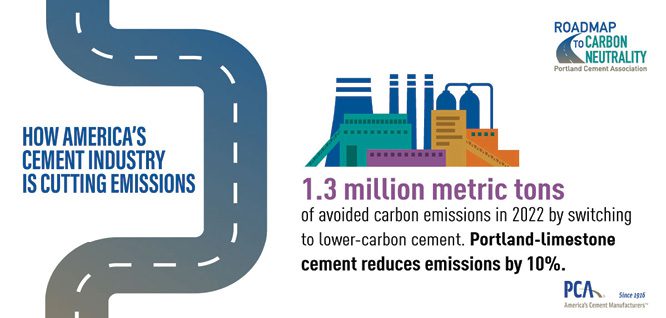
Ask for the Greener Cement—It’s Trending
Moreover, PLC is not a new product. It has been in mainstream use in Europe since the 1960s. In fact, most European countries have shifted heavily toward blended cements (including their versions of PLCs) because they offer similar performance with lower environmental footprints.
PLC is readily available through the same supply chain that already successfully serves developers, builders and contractors. Using annual cement consumption data from the U.S. Geological Survey, Portland Cement Association (PCA) estimates that during the last three years, PLC consumption totals approximately 31.8 million metric tons. Consumption of PLC experienced massive growth in 2022 as adoption grew rapidly, with an estimated 24.8 million metric tons of PLC—more than four times as much compared to the previous year.
Similarly, production of PLC has grown significantly in recent years, being produced in at least 24 of the 34 states where cement plants are located. A large share of the industry has already stated its intentions to shift to 100-percent production of PLC in cement manufacturing plants. PCA has determined that at least 35 percent of the domestic cement industry, measured by clinker capacity, has already publicly announced the transition from traditional portland cement production to full PLC production. This translates to roughly 34 million metric tons (MMT) annually of clinker, the pebble-sized lumps exiting the cement kilns that are ground into powder to make cement.
This trend is expected to grow. At least 50 plants are producing or have announced plans to produce PLC in the United States. Overall, this accounts for more than 60 percent of U.S. clinker capacity.
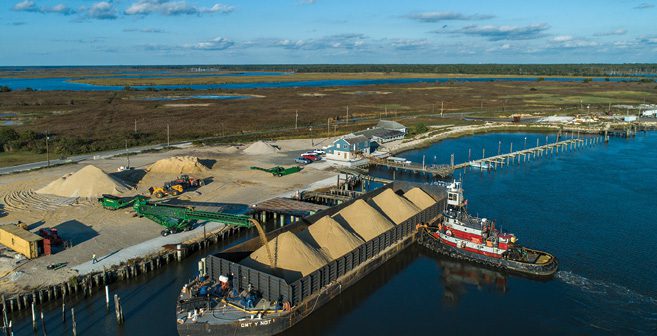

Drexel University’s 450,000-square-foot Academic Tower is constructed with portland-limestone cement for credit toward LEED certification. Heidelberg Materials
Knowing what to ask for is key to specifying PLC for projects. In the United States, PLC is commonly specified as ASTM C595 Type IL cement; in Canada, PLC is commonly specified as CSA A3000 Type GUL (read as “G-U-L”).
Although many state departments of transportation (DOTs) permit Type IL cements in their construction projects under ASTM C595, for others, AASHTO M 240 Type IL is the proper specification reference. (Of note, all technical requirements of ASTM C595 and AASHTO M 240 are the same; the specifications have been harmonized.)
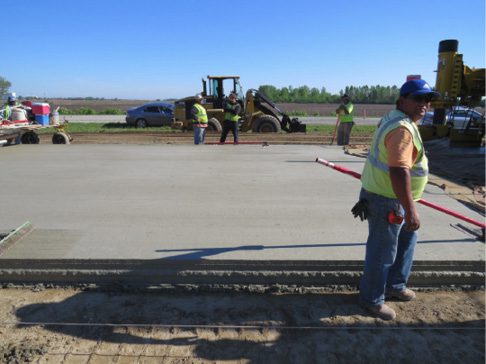

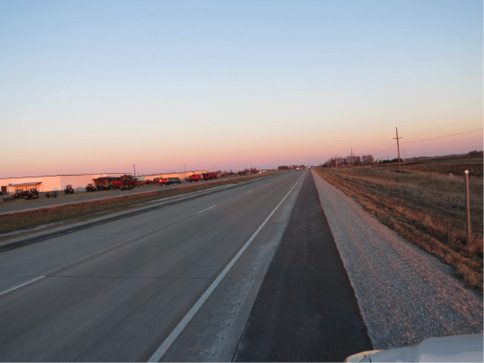
Iowa’s critical Omaha-Chicago link, U.S. Route 30, was upgraded to a four-lane expressway with low-carbon portland-limestone cement. Heidelberg Materials
Type IL is permitted:
• By codes, such as ACI 318, Building Code Requirements for Structural Concrete.
• By specifications, such as ACI 301, Specification for Structural Concrete.
• By standards, such as ASTM C94, Specification for Ready Mixed Concrete.
• By the AIA MasterSpec used by design firms to develop specifications for private projects.
Transportation Projects and PLC
To date, 46 state departments of transportation have approved the specification of PLC. The California Department of Transportation (Caltrans) adoption in January 2022 was a key advancement for lower-carbon cement, as California is the largest cement market in the United States, with some of the most-stringent environmental regulations and considerations in the country.
Interestingly, the approval of PLC by Caltrans was a proof point in more ways than one. California was not the first mover in PLC adoption—at least 40 other states had approved it earlier. Instead of following the lead of other states, Caltrans specifically commissioned Oregon State University (OSU) to conduct a study on PLC’s efficacy compared to traditional cement and waited for the results before making its decision. The study, conducted by OSU’s College of Engineering, concluded that PLC would work just as well as traditional cement, while also reducing carbon emissions and cost.
Beyond California, more innovative infrastructure is being created with PLC in nearly every state. In our nation’s heartland, U.S. Route 30 was originally constructed as part of the Lincoln Highway, the first transcontinental highway in the country that spanned from New York to San Francisco. A critical route in Iowa, connecting Omaha and Chicago, needed to be upgraded to a four-lane expressway to accommodate increasing traffic. The concrete mix included PLC; the contractor hasn’t reported any difference in placement or performance over the usual Type I/II plus fly ash mix they use.
No one appreciates bridges like Florida’s tourism industry. When traveling to the Sunshine State, motorists see that bridges are critical for Florida’s visitors because they allow access to the 663 miles of beaches and small islands along the state’s 1,350-mile-long coastline. In Pinellas County, Fla., south of St. Petersburg, the Island of Tierra Verde and its renowned beaches are accessed via a bridge. This bridge was recently replaced with a high-level, fixed bridge to reduce congestion and minimize delays related to boat traffic, and PLCs were used for much of the 17,704 cubic yards of concrete.
Of note, the Tierra Verde bridge is in a marine exposure, which is aggressive to reinforced concrete because chlorides can corrode steel. Yet durable concrete can be achieved equally well with either traditional portland cement or PLC, and the same techniques used to improve corrosion resistance of portland cement mixes are equally applicable to PLC mixes. Given equivalent durability, choosing PLC concrete makes good sense to also reduce a project’s carbon footprint.
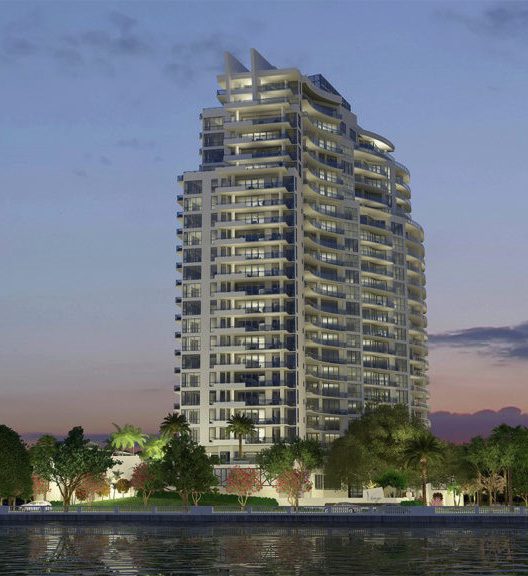
Tampa’s Virage Bayshore Condominiums, a luxurious 24-story tower, featured PLC mixes to construct the post-tensioned slabs, shear walls and columns. Argos USA
Building Projects and PLC
In addition to the 46 state transportation agencies that now have approved the use of PLC, lower-carbon cement is being used for private construction as well.
In Philadelphia, Drexel University chose PLC to build its Academic Tower, a 450,000-square-foot building, as it hoped to eventually apply for LEED certification. The concrete contractor was pleasantly surprised with the performance, sharing that, “As we started to use the new, more-sustainable mixtures, our guys didn’t say anything or notice any difference in the material from portland cement concrete. The environmental impact is definitely good for our business, and the LEED aspect helps our client and the owner.”
Back to the sunshine state, Tampa’s Virage Bayshore Condominiums, a 24-story luxury condominium tower, was constructed using PLC in mid-2020. Given its location in a coastal climate with potential exposure to hurricanes, strength as well as durability to resist corrosion were key considerations. PLC mixes were used for the 18,701 cubic yards of concrete to construct the post-tensioned slabs, shear walls and columns. For comparison, the standard cement for this type of construction would normally have been an ASTM C150 Type I/II portland cement.
For the Tampa tower, the ready-mix supplier provided mix-design submittals to help convince contractors to use PLCs for the material’s sustainable and performance aspects. PLC is specified as an ASTM C595 Type IL cement; for this project, a PLC with nominal 10-percent limestone content was used, designated as Type IL(10). For the shear walls and columns, the PLC was blended with 50-percent slag cement, meaning the load-bearing members were made with concrete that had a cement clinker content of just 40 percent compared to a historic portland-cement-only mix, which reduces the CO2 of the PLC + SCM concrete by an impressive 60 percent.
These are just a few examples of how PLC already is in use in a variety of climates across the country, delivering on the trusted strength of concrete while also reducing the carbon footprint of the construction.
Looking Ahead
In the context of global climate change, every industry is challenged to reduce its carbon footprint. Virtually every public and private construction project in the United States begins with some need for concrete, which requires cement. Manufacturer members of the PCA (representing most of the U.S. cement industry) are meeting this charge immediately with the production of PLC—while also continuing to explore other innovative, lower-emission cement blends. The U.S. cement industry is engaged in an aggressive, multifaceted approach to reach carbon neutrality (www.cement.org/sustainability/roadmap-to-carbon-neutrality), and lowering the clinker-to-cement ratio with increased limestone is a key aspect of this initiative, with the advantage of being a proven, ready-to-implement technology that’s available to every cement producer.
But the full impact of innovative cement blends can’t be realized without collaboration from partners across the construction value chain. PCA member companies shifting to 100-percent PLC production or 100-percent PLC production in certain regions, which benefits the emissions profile of the cement industry, presents a massive benefit to everyone: from those building more-sustainable concrete construction projects to the general public who wants to see reductions in the carbon footprint of society.
Breaking through institutional inertia can be a challenge, but engineers can help overcome this. There’s a huge opportunity to directly impact the sustainability outcome of a project by specifying “greener” materials that can drive the United States toward carbon neutrality. Now is the time to start using them. 
Author’s Note: For more information on the use and specification of PLC and to view additional project profiles on PLC applications, visit www.greencement.com. To view PLC availability by state, visit www.greenercement.com/plcavailability.
About James Farny
James A. Farny is director of Environmental Measurement and Metrics for the Portland Cement Association (PCA), participating in the development of PCA’s “Roadmap to Carbon Neutrality” and its campaign to raise awareness of portland-limestone cements (PLCs) and other low-carbon cements; email: [email protected].


